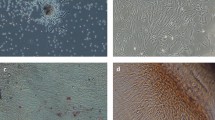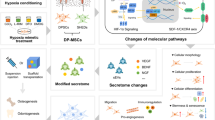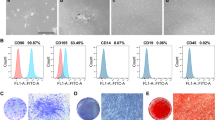Abstract
Background
Human Dental pulp derived-mesenchymal stem cells (hDP-MSCs) have the capability of selfrenewal, multipotency, as well as immunosuppressive properties. They are ideal candidates for regenerating damaged dental tissue and treating inflammation-related diseases. However, methods (such as genetic variation) to improve the immunomodulatory and regenerative efficiency of MSCs in different diseases still need to be developed. Curcumin (CUR) is known for its broad applications in regenerative medicine and the treatment of inflammatory disorders via its anti-inflammatory and anti-oxidant effects. This study was conducted to investigate the effect and underlying mechanisms of CUR on the immunomodulatory and regenerative function of hDP-MSCs and whether treating these cells with CUR can improve therapeutic efficacy.
Methods and Results
hDP-MSCs were isolated from dental pulp and then treated with CUR. Cell viability rate was observed in hDP-MSCs after treatment of CUR by MTT assay. Real-time quantitative (RT-PCR) was applied to estimate the expression of immunomodulatory and regenerative genes after treatment of CUR. The RT-PCR results showed that VEGF-A and STAT3 markers were up-regulated while HLA-G5 and VCAM-1 markers were down-regulated by CUR (20 µM) treatment in hDP-MSCs (P < 0.001). Besides, this research indicated that there were no significant changes in the expressions of RelA and DSPP after 48 h (P = 0.33, P = 1).
Conclusion
Our findings demonstrate that CUR can enhance the immunomodulatory and regenerative effects of hDP-MSCs and improve their therapeutic efficacy. These findings can give an understanding of the mechanism for improving restorative and immunomodulatory activity in hDP-MSCs by curcumin.




Similar content being viewed by others
Availability of data and material
The datasets used and analyzed during the current study are available from the corresponding author on reasonable request.
References
Qi S, Qian J, Chen F et al (2019) Expression of autophagy–associated proteins in rat dental irreversible pulpitis. Mol Med Rep 19:2749–2757. https://doi.org/10.3892/mmr.2019.9944
Nakashima M, Iohara K, Sugiyama M (2009) Human dental pulp stem cells with highly angiogenic and neurogenic potential for possible use in pulp regeneration. Cytokine Growth Factor Rev 20:435–440
Lambrichts I, Driesen RB, Dillen Y et al (2017) Dental Pulp Stem Cells: Their Potential in Reinnervation and Angiogenesis by Using Scaffolds. J Endod 43:S12–S16. https://doi.org/10.1016/j.joen.2017.06.001
Stanko P, Kaiserova K, Altanerova V, Altaner C (2014) Comparison of human mesenchymal stem cells derived from dental pulp, bone marrow, adipose tissue, and umbilical cord tissue by gene expression. Biomed Pap 158:373–377. https://doi.org/10.5507/bp.2013.078
Nuti N, Corallo C, Chan BMF et al (2016) Multipotent Differentiation of Human Dental Pulp Stem Cells: a Literature Review. Stem Cell Rev Reports 12:511–523
Sanen K, Martens W, Georgiou M et al (2017) Engineered neural tissue with Schwann cell differentiated human dental pulp stem cells: potential for peripheral nerve repair? J Tissue Eng Regen Med 11:3362–3372. https://doi.org/10.1002/term.2249
Andrukhov CB, Blufstein A, Rausch-Fan X (2019) Immunomodulatory properties of dental tissue-derived mesenchymal stem cells: implication in disease and tissue regeneration. World J Stem Cells 11:604. https://doi.org/10.4252/wjsc.v11.i9.604
Li Z, Jiang CM, An S et al (2014) Immunomodulatory properties of dental tissue-derived mesenchymal stem cells. Oral Dis 20:25–34
Lee DK, Song SU (2018) Immunomodulatory mechanisms of mesenchymal stem cells and their therapeutic applications. Cell Immunol 326:68–76. https://doi.org/10.1016/j.cellimm.2017.08.009
Yamada Y, Nakamura-Yamada S, Kusano K, Baba S (2019) Clinical potential and current progress of dental pulp stem cells for various systemic diseases in regenerative medicine: A concise review. Int J Mol Sci 20. https://doi.org/10.3390/ijms20051132
Sanen K, Martens W, Georgiou M et al (2012) Regeneration of dental pulp following pulpectomy by fractionated stem/progenitor cells from bone marrow and adipose tissue. Biomaterials 33:2109–2118
Jin Q, Yuan K, Lin W et al (2019) Comparative characterization of mesenchymal stem cells from human dental pulp and adipose tissue for bone regeneration potential. Artif Cells Nanomedicine Biotechnol 47:1577–1584. https://doi.org/10.1080/21691401.2019.1594861
Shi X, Mao J, Liu Y (2020) Pulp stem cells derived from human permanent and deciduous teeth: Biological characteristics and therapeutic applications. Stem Cells Transl Med 9:445–464
Yu J, He H, Tang C et al (2010) Differentiation potential of STRO-1 + dental pulp stem cells changes during cell passaging. BMC Cell Biol 11. https://doi.org/10.1186/1471-2121-11-32
Gao F, Hu X, Xie X et al (2014) Heat Shock Protein 90 Stimulates Rat Mesenchymal Stem Cell Migration via PI3K/Akt and ERK1/2 Pathways. Cell Biochem Biophys 71:481–489. https://doi.org/10.1007/s12013-014-0228-6
Mabuchi Y, Morikawa S, Harada S et al (2013) LNGFR + THY-1 + VCAM-1hi + cells reveal functionally distinct subpopulations in mesenchymal stem cells. Stem Cell Reports 1:152–165. https://doi.org/10.1016/j.stemcr.2013.06.001
Yu S, Li P, Li B et al (2020) RelA promotes proliferation but inhibits osteogenic and chondrogenic differentiation of mesenchymal stem cells. FEBS Lett 594:1368–1378. https://doi.org/10.1002/1873-3468.13739
Mandrol PS, Bhat K, Prabhakar AR (2016) An in vitro evaluation of cytotoxicity of curcumin against human dental pulp fibroblasts. J Indian Soc Pedod Prev Dent 34:269
Saharkhiz M, Razavi FE, Riahi SM et al (2021) An in Vitro Study of the Effects of Crocin on the Modulation of DSPP, VEGF-A, HLA-G5, STAT3 and CD200 Expression in Human Dental Pulp Stem Cells. Cell Reprogram 23:239–249. https://doi.org/10.1089/cell.2021.0032
Mohammadi A, Blesso CN, Barreto GE et al (2019) Macrophage plasticity, polarization and function in response to curcumin, a diet-derived polyphenol, as an immunomodulatory agent. J Nutr Biochem 66:1–16
Kahkhaie KR, Mirhosseini A, Aliabadi A et al (2019) Curcumin: a modulator of inflammatory signaling pathways in the immune system. Inflammopharmacology 27:885–900
Ahangari N, Kargozar S, Ghayour-Mobarhan M et al (2019) Curcumin in tissue engineering: A traditional remedy for modern medicine. BioFactors 45:135–151
Gronthos S, Arthur A, Bartold PM, Shi S (2011) A method to isolate and culture expand human dental pulp stem cells. Methods Mol Biol 698:107–121. https://doi.org/10.1007/978-1-60761-999-4_9
Al-Habib M, Huang GTJ (2019) Dental mesenchymal stem cells: Dental pulp stem cells, periodontal ligament stem cells, apical papilla stem cells, and primary teeth stem cells—isolation, characterization, and expansion for tissue engineering. Methods in Molecular Biology. Humana Press Inc., pp 59–76
Di Scipio F, Sprio AE, Carere ME et al (2017) A simple protocol to isolate, characterize, and expand dental pulp stem cells. Methods in Molecular Biology. Humana Press Inc., pp 1–13
Sinjari B, Pizzicannella J, D’Aurora M et al (2019) Curcumin/liposome nanotechnology as delivery platform for anti-inflammatory activities via NFkB/ERK/pERK pathway in human dental pulp treated with 2-HydroxyEthyl MethAcrylate (HEMA). https://doi.org/10.3389/fphys.2019.00633. Front Physiol 10:
Wang N, Wang F, Gao Y et al (2016) Curcumin protects human adipose-derived mesenchymal stem cells against oxidative stress-induced inhibition of osteogenesis. J Pharmacol Sci 132:192–200
Trubiani O, Cataldi A, De Angelis F et al (2012) Overexpression of interleukin-6 and-8, cell growth inhibition and morphological changes in 2-hydroxyethyl methacrylate-treated human dental pulp mesenchymal stem cells. Int Endod J 45:19–25. https://doi.org/10.1111/j.1365-2591.2011.01942.x
Murray PE, Garcia-Godoy F, Hargreaves KM (2007) Regenerative endodontics: a review of current status and a call for action. J Endod 33:377–390
Diogenes A, Hargreaves KM (2017) Microbial modulation of stem cells and future directions in regenerative endodontics. J Endod 43:S95–S101
Fioretti F, Mendoza-Palomares C, Avoaka-Boni MC et al (2011) Nano-odontology: nanostructured assemblies for endodontic regeneration. J Biomed Nanotechnol 7:471–475
Kornicka K, Kocherova I, Marycz K (2017) The effects of chosen plant extracts and compounds on mesenchymal stem cells—a bridge between molecular nutrition and regenerative medicine- concise review. Phyther Res 31:947–958
Qureshi M, Al-Suhaimi EA, Wahid F et al (2018) Therapeutic potential of curcumin for multiple sclerosis. Neurol Sci 39:207–214
Attari F, Zahmatkesh M, Aligholi H et al (2015) Curcumin as a double-edged sword for stem cells: Dose, time and cell type-specific responses to curcumin. DARU. J Pharm Sci 23:2703–2706. https://doi.org/10.1186/s40199-015-0115-8
Cao F, Hata R, Zhu P et al (2010) Conditional deletion of Stat3 promotes neurogenesis and inhibits astrogliogenesis in neural stem cells. Biochem Biophys Res Commun 394:843–847
Chu X, Xu B, Gao H et al (2019) Lipopolysaccharides Improve Mesenchymal Stem Cell-Mediated Cardioprotection by MyD88 and stat3 Signaling in a Mouse Model of Cardiac Ischemia/Reperfusion Injury. Stem Cells Dev 28:620–631. https://doi.org/10.1089/scd.2018.0213
Xu K, Xiao J, Zheng K et al (2018) MiR-21/STAT3 Signal Is Involved in Odontoblast Differentiation of Human Dental Pulp Stem Cells Mediated by TNF-α. Cell Reprogram 20:107–116. https://doi.org/10.1089/cell.2017.0042
Liu Q, Ji S, Xia T et al (2020) MCP-1 Priming Enhanced the Therapeutic Effects of Human Mesenchymal Stromal Cells on Contact Hypersensitivity Mice by Activating the COX2-PGE2/STAT3 Pathway. Stem Cells Dev 29:1073–1083. https://doi.org/10.1089/scd.2020.0035
Vigo T, Rocca C, La, Faicchia D et al (2019) IFN? enhances mesenchymal stromal (Stem) cells immunomodulatory function through STAT1-3 activation and mTOR-associated promotion of glucose. Cell Death Discov 10:1–8
Ma X-X, Liu J, Wang C-M et al (2018) Low-dose curcumin stimulates proliferation of rat embryonic neural stem cells through glucocorticoid receptor and STAT3. Wiley Online Libr 24:940–946. https://doi.org/10.1111/cns.12843
Sakamori R, Takehara T, Ohnishi C et al (2007) Signal transducer and activator of transcription 3 signaling within hepatocytes attenuates systemic inflammatory response and lethality in septic mice. Hepatology 46:1564–1573. https://doi.org/10.1002/hep.21837
Liu X, Lee YS, Yu C-R, Egwuagu CE (2008) Loss of STAT3 in CD4 + T Cells Prevents Development of Experimental Autoimmune Diseases. J Immunol 180:6070–6076. https://doi.org/10.4049/jimmunol.180.9.6070
Ijaz T, Sun H, Pinchuk IV et al (2017) Deletion of NF-κB/RelA in angiotensin II-sensitive mesenchymal cells blocks aortic vascular inflammation and abdominal aortic aneurysm formation. Arterioscler Thromb Vasc Biol 37:1881–1890. https://doi.org/10.1161/ATVBAHA.117.309863
Doukas SG, Doukas PG, Sasaki CT, Vageli D (2020) The in vivo preventive and therapeutic properties of curcumin in bile reflux-related oncogenesis of the hypopharynx. J Cell Mol Med 24:10311–10321. https://doi.org/10.1111/jcmm.15640
Dehghani S, Dalirfardouei R, Jafari Najaf Abadi MH et al (2020) Topical application of curcumin regulates the angiogenesis in diabetic-impaired cutaneous wound. Cell Biochem Funct 38:558–566. https://doi.org/10.1002/cbf.3500
Wei Y, Zhang L, Chi Y et al (2020) High-efficient generation of VCAM-1 + mesenchymal stem cells with multidimensional superiorities in signatures and efficacy on aplastic anaemia mice. Cell Prolif 53. https://doi.org/10.1111/cpr.12862
Soltani B, Bodaghabadi N, Mahpour G et al (2016) Nanoformulation of curcumin protects HUVEC endothelial cells against ionizing radiation and suppresses their adhesion to monocytes: potential in prevention of radiation-induced atherosclerosis. Biotechnol Lett 38:2081–2088. https://doi.org/10.1007/s10529-016-2189-x
Zahedpanah M, Takanlu JS, Nikbakht M et al (2019) Microvesicles of osteoblasts modulate bone marrow mesenchymal stem cell-induced apoptosis to curcumin in myeloid leukemia cells. J Cell Physiol 234:18707–18719. https://doi.org/10.1002/jcp.28511
Du WJ, Reppel L, Leger L et al (2016) Mesenchymal Stem Cells Derived from Human Bone Marrow and Adipose Tissue Maintain Their Immunosuppressive Properties after Chondrogenic Differentiation: Role of HLA-G. Stem Cells Dev 25:1454–1469. https://doi.org/10.1089/scd.2016.0022
Haddad R, Saldanha-Araujo F (2014) Mechanisms of T-cell immunosuppression by mesenchymal stromal cells: What do we know so far? Biomed Res Int 2014:1–14
Yang Q, Leong SA, Chan KP et al (2021) Complex effect of continuous curcumin exposure on human bone marrow-derived mesenchymal stem cell regenerative properties through matrix metalloproteinase regulation. Basic Clin Pharmacol Toxicol 128:141–153. https://doi.org/10.1111/bcpt.13477
Deshpande AS, Fang PA, Zhang X et al (2011) Primary structure and phosphorylation of dentin matrix protein 1 (DMP1) and dentin phosphophoryn (DPP) uniquely determine their role in biomineralization. Biomacromolecules 12:2933–2945. https://doi.org/10.1021/bm2005214
Kamar SS, Abdel-Kader DH, Rashed LA (2019) Beneficial effect of Curcumin Nanoparticles-Hydrogel on excisional skin wound healing in type-I diabetic rat: Histological and immunohistochemical studies. Ann Anat 222:94–102. https://doi.org/10.1016/j.aanat.2018.11.005
Acknowledgements
The authors would like to thank the research assistant of Birjand University of Medical Sciences, Birjand, Iran for the support during this study.
Funding
This study was funded by Birjand University of Medical Sciences, under grant No.456181.
Author information
Authors and Affiliations
Contributions
Malaksima Ayadilord: Study design, Executor of the plan, Analysis and Interpretation of data and Drafting of the manuscript. Mansoore Saharkhiz: Study design, Executor of the plan, Analysis and Interpretation of data and Drafting of the manuscript. Dr Mohsen Naseri: Study design, Edit and Critical revision of the manuscript for important intellectual content. Dr Fariba Emadian Razavi: Material support, Study design, Executor of the plan, Supervision and Interpretation of data and Editing of the manuscript. *All authors read and approved the final manuscript.
Corresponding author
Ethics declarations
Conflict of interest
All authors declare no competing interests.
Ethics Approval and Consent to Participate
Using human-DPSC (hDPSC), a discarded human third molar (wisdom tooth) was received after obtaining the consent of the patient. The subject underwent treatment at the Dental Department of the Imam Reza Hospital (Birjand, Iran) after receiving approval from the Ethics Committee of Birjand University of Medical Science (approval number: IR.BUMS.REC.1399.157).
Consent for publication
Not applicable.
Additional information
Publisher’s Note
Springer Nature remains neutral with regard to jurisdictional claims in published maps and institutional affiliations.
Rights and permissions
About this article
Cite this article
Ayadilord, M., Saharkhiz, M., Naseri, M. et al. Expression of immunomodulatory and tissue regenerative biomarkers in human dental pulp derived-mesenchymal stem cells treated with curcumin: an in vitro study. Mol Biol Rep 49, 4411–4420 (2022). https://doi.org/10.1007/s11033-022-07278-4
Received:
Revised:
Accepted:
Published:
Issue Date:
DOI: https://doi.org/10.1007/s11033-022-07278-4




